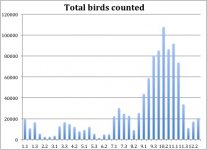OK, so weather and time of year. This is my gut feel view rather than anything I have done statistically – I’m sure that will come as I have all the data ready should I ever get the urge (and the time) to do it properly - I’ve 8 years of data with over a million birds logged (although how many times an individual Brent has been counted over the years is anyone’s guess!)
Winter
Red-throated Divers are offshore from mid-late December until late March but timing of numbers etc varies. There tends to be an influx in late December, then in some years birds are offshore continually, or they disappear offshore/elsewhere and turn up depending on where the food is. Fresh onshore winds will be most productive, usually SW – late skuas, Kittiwakes in particular, but anything from NE-SE-SW is worth a look.
Spring
Early spring then light to moderate winds between NE and S. There seems to be a good chance of adult Gannet passage as soon as there is any strength in a wind from the east, whilst divers and cormorants are also involved.
By April, then a moderate onshore between E and S might produce the odd skua, some Common Scoter passage (some years v noticeable as in 2013), whilst lighter winds will see Brent departing but these are crack of dawn birds. Mornings with light winds will generally see some Black Headed Gull passage (plus diurnal land migrants). Fulmars are best seen in April and May- in light winds often flying along the edge of the undercliff over the Greensward. Stronger winds see them over the sea more as expected although they can appear at any range in any conditions.
Late April- early May – easterly element is best. Might produce a few terns and waders (Barwits and Whimbrel) – often get a wader passage on a sunny evening with birds heading into a decent headwind. Hit and miss for other things, but if a strong enough easterly then chance of a skua perhaps.
Summer
June tends to be a quiet month – perhaps some Swift movement and if any decent breeze then a chance of a few Gannets. Fresh NE can give a small evening movement of adult Kittiwakes which are presumably birds heading back to the Suffolk colonies. Returning Curlew are most prominent – a decent SW breeze needed to get them down over the sea and visible. Similar in July but a increasing variety of waders, often a good passage of presumed immature Common Scoter and some terns appearing from mid-month. Best chance of movement of the latter is late afternoon and evening with a light onshore breeze.
Autumn – which I’m including August to December!
August is terns and waders as per July, with a few skuas appearing and wildfowl as the month wears on. Also chance of shearwaters increases etc. Best conditions seem to be strong SW, particularly following a weather window where birds leave the ?Low Countries? in fine weather only hit an Atlantic depression tracking east. This applies throughout the autumn , so big movements of Brent, Scoter and Dunlin (for example) can occur.
Other species (notably Brent and wildfowl) move with an E-SE tailwind so from mid-September a switch in wind direction to the east will result in movement, although sometimes not until lunchtime or early afternoon, presumably as birds left at first light. Brent move in numbers from mid September to end October, with lots of Wigeon in with the earlier movements.
However, strong winds from the North (anywhere between NW and NE) can see a northward passage of birds re-orienting from the Outer Thames area. Sometimes you can see the southbound passage but it is unusual and often distant (e.g. 2012 I think when 500+ Gannet and 100+ southbound skuas one day was exceptional) . Peak passages of Gannet back north normally occur the day after a good northerly blow.
For shearwaters – particularly Sooty- a mid-September fresh SE-E wind is best and birds can be quite close in off Frinton and Holland Haven. Manx are just as likely to be seen heading south as well as north and generally into a headwind. Rarer things like Cory’s (both those fully identified and distant probable) have been seen in both fresh SW and SE-E conditions - best chance is after a strong SW-W airstream which has either pushed birds around Scotland into the North Sea or pushed them up the Channel.
By November focus is more on seaduck and waders – best chance of a few Velvet Scoter, Goldeneye, Goosander, movement of Shelduck, Eider and Mergs, plus other oddities – smaller auks, Snipe etc. The variety in early November watches is challenging at times although numbers are reduced compared to November. Same conditions again are best – autumn 2013 saw some huge Dunlin movement as winds freshened rapidly from the SW following a clear night. This also give the excitement of Starling and thrushes arriving,
Seaduck passage can continue right through December, and then it is a case of waiting of the divers to return in numbers.
Just realized I haven’t mentioned diurnal passage during the autumn… Perhaps slightly off topic but since I’ve written an essay already I might as well include them next!
Hope this is of some use and I haven’t bored the pants off you all. If there was something moving at sea today I probably would have written less ;0)
Paul





